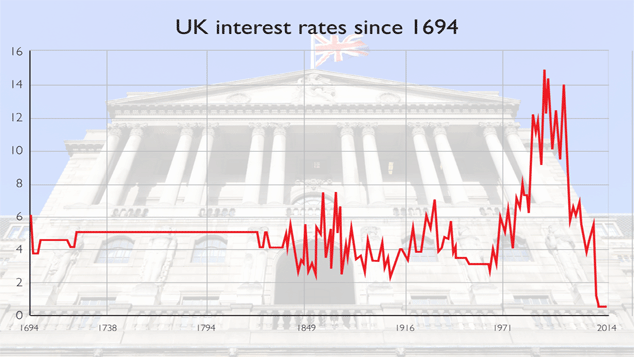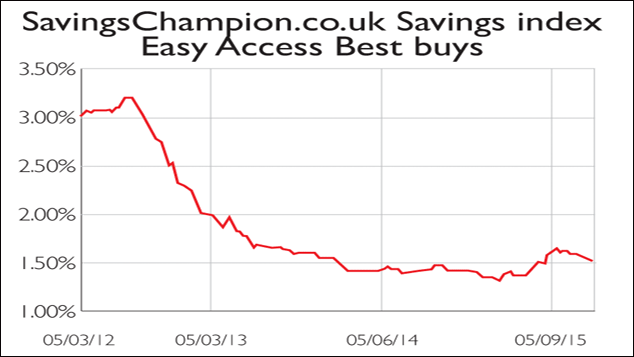Beat flatlining interest rates with the 5% solution
The “new normal” of below 2% is bad news for income-orientated investors – but accept a bit of risk and there’s still money to be made, says David C Stevenson.


When I'm not writing about investing, I spend a fair bit of time moderating events with City analysts, bankers and hedge-fund managers. Mostly these are think-ins off-the-record sessions run on Chatham House rules, where everyone is asked to think the unthinkable. At one such event late last year, all the attendees were given iPads, to allow instant voting on a series of polls.
The most striking question by far was this one: "When do you think interest rates will be above 2% for more than a year? Type a year". More than 100 people answered. Within seconds, a single number shot up on screen. On average, our experts thought the current lower-rate environment would end in... 2048. In other words, if they're right, we won't see rates in the developed world remain consistently above 2% for 32 years.
Now look at the chart. It shows UK interest rates over the last few hundred years our editor-in-chief Merryn Somerset Webb has described it as the "most important chart in the world". Amid the ups and downs, it's pretty clear the long-term average has been around 5% (it's a similar story in the US).
MoneyWeek
Subscribe to MoneyWeek today and get your first six magazine issues absolutely FREE

Sign up to Money Morning
Don't miss the latest investment and personal finances news, market analysis, plus money-saving tips with our free twice-daily newsletter
Don't miss the latest investment and personal finances news, market analysis, plus money-saving tips with our free twice-daily newsletter
And in all this time, rates have never stayed below 2% for a period of decades. So if our group of financial experts is right, and we're in for 30-odd years of sub-2% rates, then something has changed.

Are we really facing a "new normal", or is this just groupthink? The truth is that I think there's a very good chance that we are indeed in a new era, where rates never budge much above 2% for more than a year. This doesn't preclude a rise from today's 0.5% rate to, say, 1.75%, or even a short-term spike above 2% to 2.5% (imagine how high those levels would feel compared with today). But overall, I maintain that rates will probably remain below the 2% trend for extended periods. What's changed?
It boils down to one small word: debt. Put simply, we're drowning in debt collectively governments, consumers, companies and as a result, we can't afford to pay higher interest rates. As consultancy giant McKinsey recently pointed out, global debt has actually risen, rather than fallen, since the financial crisis by a whopping $57trn. Once you grasp this critical point, everything else seems so obvious.
In short, the world is so heavily indebted that it simply cannot withstand interest rates moving closer to the long-term average of 5%. Any significant rise in rates could plunge the global economy into debt-deflation (as insolvent borrowers are forced to sell assets at fire-sale prices to pay their creditors), which is the last thing that central banks or governments want. There are many factors behind this, but the upshot is that it seems unlikely that interest rates in the developed world will push much above 2% in the near term and if they do get there, it'll likely coincide with the next recession, at which point rates will be pushed back down.
How long will this "new normal" last? Central banks might change their core philosophy and move to much higher rates, or maybe inflation will erupt, forcing rates higher. But overall, I suspect we are looking at another decade, if not longer, of sub-2% interest rates. While 2048 might be pushing it, the structural reasons driving low rates don't look like changing anytime soon.
Financial repression
All of which is bad news for anyone seeking an income from their savings or investments. The chart below is from the website Savings Champion. It's an index of "best buy" savings accounts, and it shows how rates have changed since March 2012.
The message is clear. Savings rates have been falling for years, and this harsh income environment is unlikely to improve much even if interest rates do rise to 1% or more.
What's true for savings products is also true for a range of income-producing financial assets, including annuities (which provide you with a lifetime income in exchange for a pot of capital). Yields on bonds (government and corporate IOUs) have collapsed.

In some countries, rates are even in negative territory that is, central banks are charging commercial banks for depositing money with them. That spells hard times for income-orientated investors bad timing, given that the government's new pension freedoms are putting ever more responsibility on individual investors to generate a decent income for their "third age".
But it doesn't have to be bad news. If you are prepared to get active and creative in your investment strategy, then there are alternative options for creating an income portfolio out there, which I think could provide a sustainable income of 5% or more per year.
Why target 5%? Because that's around the long-run interest-rate average, and because 5% is not far off the regular income yield you'd receive on a bog standard pension annuity for a 65-year-old male (most annuities will pay around £5,500 per annum for a lump sum of £100,000 invested the difference being that once you buy the annuity, the lump sum is gone).
The 5% solution
So what options are out there? If safe income is your priority, there are alternatives to a savings account. But you have to have realistic expectations if the government will only pay around 2% for borrowing for ten years, then risk-free assets are unlikely to offer much above 2.5% at the most, with 1.5 to 2% the more likely range for "safeish" assets. If you're willing to work a bit harder and to accept some risk to your capital (that is, prices might go down as well as up), you can get that range up to 2.5% to 4% a year.
At that sort of level the risks shouldn't be massive, but they are real you have to think less like a saver and more like an investor. Yet these rates are still likely to be too low for many of our readers. So I would focus on the 4%-6% range. This is a sensible level of reward for an investor who is willing to take calculated risks and to do the hard work of understanding their investments. I think that the risk-reward balance at this level is ample enough to justify the research required.
Why not go higher? Well, in the 6%-8% territory, I'd say there are still some decent ideas (I've a few on my radar right now), but at this level risk starts to increase dangerously, and you need to be alert to hidden risks and dangerous complexity. And once we get to 8% a year or more, you are heading into profoundly dangerous territory again there are isolated opportunities but they are few and far between, and so expect very substantial volatility.
Overall I think that targeting a DIY portfolio paying an annual income of around 5% with hope of some limited capital gains is a realistic and achievable goal for most investors, as long as you are willing to take some sensible risks.
So what sort of investment should we look for? When searching for income-producing assets, I particularly like assets that could be repriced in the future. When I first started investing in listed funds that invest in infrastructure assets, at the end of the last decade, the typical yield was close to 6.5%. But as investors grew more comfortable with these assets, share prices steadily rose. Now the average yield is closer to 4.5%.
But if rates stay low for a very long time, even that could seem high. Investors might think that because these funds are full of long-term, inflation-linked, government-managed assets, a 3.5% yield is more appropriate. That in turn implies that the share prices would rise. So not only do you get the original yield you invested at, you also make a capital gain.
Infrastructure assets are just one example of how income-producing assets can benefit in the longer run from being repriced, particularly those that are "alternative" or difficult to understand without closer analysis and there are plenty such assets out there.
These funds also illustrate the benefits of another key strategy for income investors thinking like a bank. Before the financial crisis, the big banks used to play a major role in funding infrastructure; but after the crash, fragile balance sheets and new regulations saw banks withdraw from many lending fields, leaving scores of specialist markets in crisis.
A vast group of alternative lenders has emerged to fill the funding gaps. In the case of infrastructure, these funds stepped into the gap. The lesson for investors is that you should think like the banks used to look at every market and opportunity, see if there is a way of providing capital, and then receive an appropriate income return.
Of course, you also need to ensure that you avoid the banks' mistakes diversify across different assets, investments and business sectors, rather than becoming overly exposed to one sector, such as US housing. Finally, make sure that your loans are backed by something substantial. We're not just talking about property (though that provides good protection) but also ensuring that your income is being produced by businesses and organisations with real cash flows and robust balance sheets.
I look at one such investment below, and I'll be building a full portfolio of these opportunities, with the goal of an overall 5% yield, in the Lifetime Wealth newsletter in the coming months.
Robust investments the charitable solution
Here, I want to look at a retail bond (one that can be bought on the London Stock Exchange by private investors). The bond is issued by Retail Charity Bonds plc, in order to raise money for the Charities Aid Foundation (CAF). The ten-year bond pays a 2.5p coupon [interest] per 100p bond every six months. It's trading at around 106p, which implies a running yield (the annual coupon payment divided by the price paid) of about 4.7%. The yield to maturity (which takes into account the fact that you only get 100p back in ten years' time, not 106p) is just over 4.1%.
Who are we lending to? The CAF is a well-established charity (founded in 1924), which helps individuals and companies to donate to charity, and to reclaim tax relief on those contributions you go to the website, set up an account, pay money in and then decide how you'd like to donate it. The CAF, in effect, acts as a clearing house for donors particularly useful for companies and their internal charity-giving programmes. It has 250,000 individual and 3,000 corporate account holders. It also offers an advisory service for family offices and foundations, organises payroll giving for firms, and advises charities on everything from investing to securing grants.
So what's backing our loan? The bond is secured on the CAF, which has several sources of income, including interest made on cash balances held with it (if you keep money on account with the CAF, you don't get interest). It picks up fees for giving advice, and makes a small administrative charge for providing accounts to all those corporations.
In 2015 it had donations of just under £5.5m, charitable fee income of £9.2m and investment income of £6.4m totalling £21m. Operating expenses and further donations ran at just under £21m, equating to a profit of £100,000 last year. The CAF is not a profit-making organisation it is designed to help charitable giving, and so recycles its money back into that task. This means it could well run at a loss at some point, if it felt this was appropriate. But the CAF also knows that its main focus has to be repaying the bond and making those interest payments so it'll simply dial back spending if necessary.
Crucially, the CAF has no existing indebtedness no other creditors. It's also sitting on a huge mountain of "restricted assets" cash ready to be deployed to help other charities. In the very worst scenario, the £20m bondholders can call on over £864m of liquid restricted assets (which are in turn generating some income).
So why does the CAF want the money? Because it also owns CAF Bank. This 30-year-old bank works with 17,000 other charities to provide low-cost financial services. It has about 10% of the market, and boasts a very conservative balance sheet. It has capital of £20m, and deposits of £1bn. About a quarter of this £1bn is loaned to other banks. About 66% is in ultra-safe government (or quasi-government) bonds. A tiny £20m is lent out to other charities. The bank would like to use the proceeds of this bond to grow its loans to around £100m, which should in turn boost profits, which ran at about £2.2m last year (which is remitted back to the CAF).
So the CAF is lending the money raised by the bond to the CAF Bank (which it owns), which will in turn allow the bank to lend more to other charities a giant financial feedback loop. In financial terms, the bond is secured on the CAF, but the CAF is then lending the money on to the bank via a "subordinated" loan which means after paying out to the depositors, that money must be repaid first.
But hopefully the extra cash will help this already profitable, very conservatively run bank to grow its own loan book, which should in turn produce even more profits, which will be remitted to the CAF to help repay the loan. And the balance sheet of the CAF itself is in any case incredibly strong, with what I'd say is a relatively low chance of a default.
The final question is the income sufficient? Our goal is to get 5% on the whole portfolio. I'd say that in this specific case, the risk to your capital is low, so any yield above 4% for ten years is acceptable. Interest rates could rise over the next decade, making that yield less attractive, but my sense is that this is one of the safest charities out there, akin to an investment-grade (lower-risk) corporate issuer for the voluntary sector, and that it would make a good addition to any income portfolio.
| Issuer | Retail Charity Bonds PLC for the Charities Aid Foundation |
| Expected maturity | 12 April 2026 (ten years) |
| Coupon | 5% p.a., semi-annually in arrears on 12 April and 12 Oct |
| Current yield | 4.16% |
| Issue price | 100p |
| ISIN | XS1386668591 |
| SEDOL | BZ8THC4 |
| ORB TIDM | CAF1 |
David C Stevenson has joined the Lifetime Wealth newsletter as income specialist. Click here for more on Lifetime Wealth.
Get the latest financial news, insights and expert analysis from our award-winning MoneyWeek team, to help you understand what really matters when it comes to your finances.

David Stevenson has been writing the Financial Times Adventurous Investor column for nearly 15 years and is also a regular columnist for Citywire.
He writes his own widely read Adventurous Investor SubStack newsletter at davidstevenson.substack.com
David has also had a successful career as a media entrepreneur setting up the big European fintech news and event outfit www.altfi.com as well as www.etfstream.com in the asset management space.
Before that, he was a founding partner in the Rocket Science Group, a successful corporate comms business.
David has also written a number of books on investing, funds, ETFs, and stock picking and is currently a non-executive director on a number of stockmarket-listed funds including Gresham House Energy Storage and the Aurora Investment Trust.
In what remains of his spare time he is a presiding justice on the Southampton magistrates bench.
-
 Investors will reap long-term rewards from UK equities
Investors will reap long-term rewards from UK equitiesOpinion Nick Train, portfolio manager, Finsbury Growth & Income Trust, highlights three UK equities where he’d put his money
-
 The graphene revolution is progressing slowly but surely
The graphene revolution is progressing slowly but surelyEnthusiasts thought the discovery that graphene, a form of carbon, could be extracted from graphite would change the world. They might've been early, not wrong.